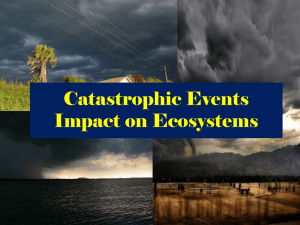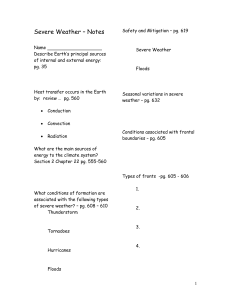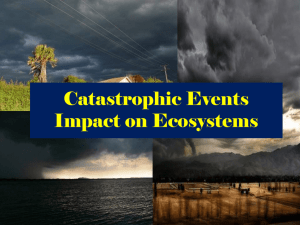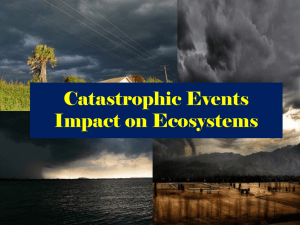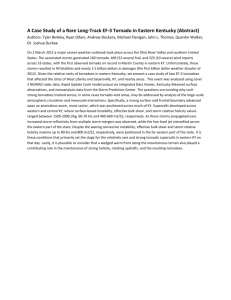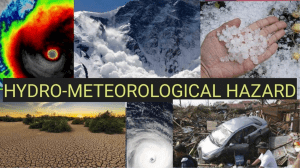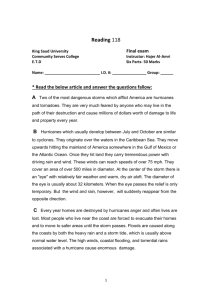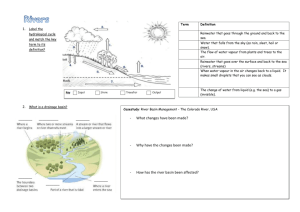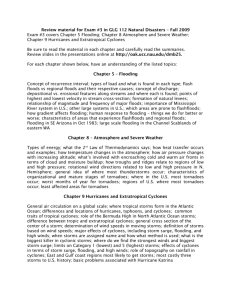Sydney Seleena Maddie - Extreme Weather Notes
advertisement
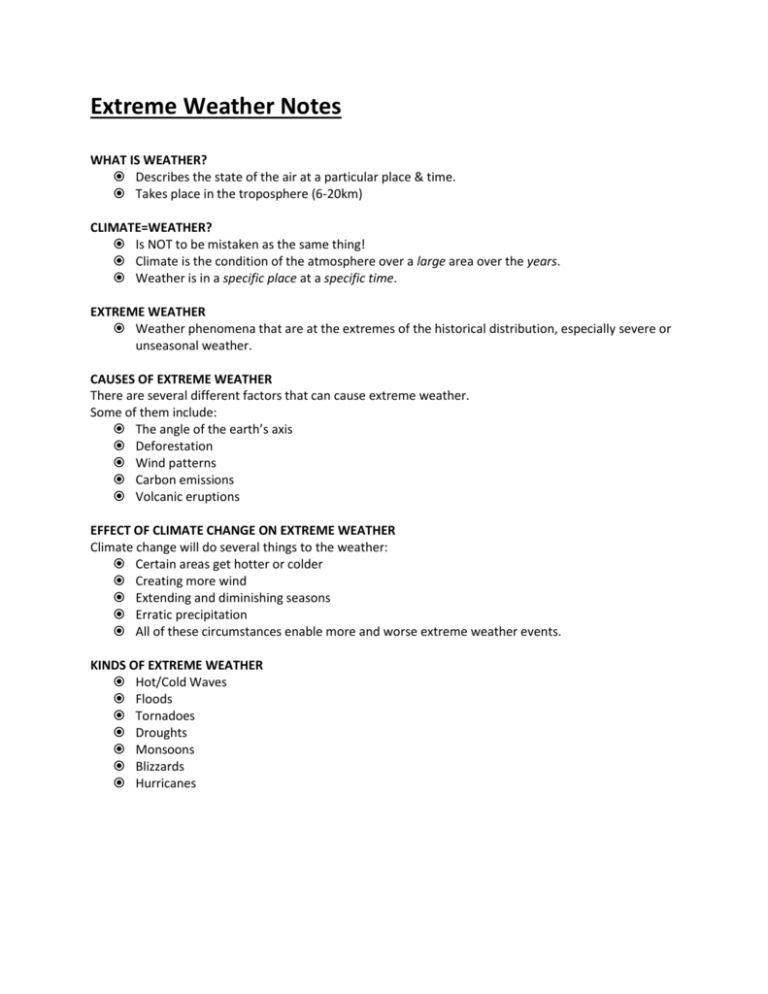
Extreme Weather Notes WHAT IS WEATHER? Describes the state of the air at a particular place & time. Takes place in the troposphere (6-20km) CLIMATE=WEATHER? Is NOT to be mistaken as the same thing! Climate is the condition of the atmosphere over a large area over the years. Weather is in a specific place at a specific time. EXTREME WEATHER Weather phenomena that are at the extremes of the historical distribution, especially severe or unseasonal weather. CAUSES OF EXTREME WEATHER There are several different factors that can cause extreme weather. Some of them include: The angle of the earth’s axis Deforestation Wind patterns Carbon emissions Volcanic eruptions EFFECT OF CLIMATE CHANGE ON EXTREME WEATHER Climate change will do several things to the weather: Certain areas get hotter or colder Creating more wind Extending and diminishing seasons Erratic precipitation All of these circumstances enable more and worse extreme weather events. KINDS OF EXTREME WEATHER Hot/Cold Waves Floods Tornadoes Droughts Monsoons Blizzards Hurricanes 1. HEAT WAVES/COLD WAVES Heat waves: A long time of very high temperatures No definition for heat waves, it happens all over the world and differs in temperature (i.e. if the Yukon had a heat wave it would greatly differ from Africa having a heat wave) Very hot and high levels of humidity causes relative temperature to increase to dangerous levels Not visible Has severe effects such as, death of livestock and wildlife Effects directly affecting the human population are: dehydration, heat cramps, heat expansion, heat stroke Soil dries out making it hard to cultivate land for agriculture More frequent breaks of wildfires due to dryness of the land Lakes, rivers, ponds, oceans being dried up as well Power outages due to the demand of electricity Cold Waves: Rapid fall in temperature within 24hr Causes death of livestock and wildlife Exposure to freezing temperatures makes it hard for animals to get the food needed causing them to die of starvation or hypothermia Freezes water pipes If water main breaks water become hard to maintain (this makes firemen’s jobs very difficult) Use of electrical heating rises Fires are VERY dangerous Transportation gets very difficult due to motors of vehicles freezing Canada and Siberia receive very cold weather Breathing air is dense (more oxygen) Winter in Canada greatly differs from Australia’s but a big decrease from the normal temperature in Australia are just as destructive Year without summer 1815 random cold periods in summer due to volcanic eruption 2. FLOODS HUGE overflow of water that covers land Water escapes its usual home Can occur in any form of body of water Occurs when water expands so much it has no were else to go but nearby villages or cities Damage to houses, businesses can be eliminated by moving away from bodies of water but living nearby to water for some people is the only way of work, food and shelter Damage to all types of buildings Decrease in population due to drowning Clean water mixes with dirty flood water resulting in no drinking water Water diseases Crop and food significantly decrease Trees and plants die Loss of property causes economic struggles Dams, levees, bunds, reservoirs, weirs are used as precautionary tactics to maintain a flood If those fail sandbags and tubes are used KINDS OF FLOODS: Riverine- Slow kinds: Caused by rainfall, fast snow melting, Excess rain from monsoons,huricanes as well as blocked drains not letting water go anywhere else o Fast kinds: Flash floods from thunder storms, breakage of a dam, landslide Coastal- Caused by sea storms or aftermath of a tsunami or hurricane Catastrophic- Caused by unexpected event Muddy- Caused by excess materials from crops mixed with water BENEFITS: Recharges the ground/roots Helps the soil for future growths Waters down extreme dry areas Creates new ecosystems 3. TORNADOES The most violent storm known to man Only affects a small portion of land Average deaths of 150/year Average 12.8 million in property damage/year Tornado is linked to a strong thunderstorm 70% of all tornadoes happen in the U.S Usually occur in late spring or early summer but can happen at any time min speed of 60mph max speed of 300mph 10 miles long, 100 ft wide It’s path is very narrow but travels very fast The magnitude of a tornado is measured on the Fujita scale Shaped like a column (tube) with a cloud at the top Travels a few miles before disintegrating EFFECT ON HUMANS Weather plays an important role in how humans go about their daily lives Extreme weather has an even larger impact. In the case of hurricanes, tornadoes, and floods, extreme weather can destroy people’s houses or even kill. (Ex. Hurricane Katrina in 2005 killed at least 1,836 and created an estimated $81 billion in damages) Drought and dust storms can destroy crops ad bankrupt farmers. (Ex. In the 1930s during the depression there was a huge drought in western North America in which no crops were growing.) STORM TRACKING AND MEASURING WEATHER Storm tracking Meteorological centres use several different technologies to track the weather these include: Satellite imaging Pulse-Doppler radar [motion of precipitation] Rain gauge Weather vane [direction of wind] Anemometer [wind speed] Barometer [air pressure] Hygrometer [humidity] Scientists often send instruments up into the atmosphere using weather balloons to get more accurate data. Measuring Weather Each type of weather event is unique and so each is measured in a different way Volcanoes are measured with the Volcanic Explosivity Index [A scale of 1-8 based on volume of debris and cloud, cloud height, and visual observations] Tornadoes are measured using the Fujita Scale [ranging from F0 (weakest) to F5 (strongest) based on the damage the tornado inflicts on man-made structures and vegetation] Tropical cyclones (also called hurricanes or typhoons) are measured using the Beaufort scale [012 based on the speed of 10-minute sustained winds] Floods are measured in how many meters of water there are above the normal ground level Hail is measured by the average diameter of the hail stones CONCLUSION There are many different kinds of weather and different places on the planet experiences different types of weather based on a number of factors. All weather, regardless of the severity, impacts human society and human society has an impact on the weather through our part in the changing climate.

